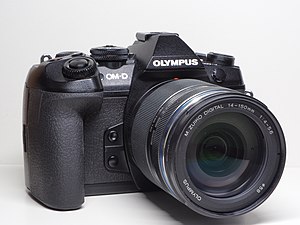 | |
| Overview | |
|---|---|
| Maker | Olympus |
| Type | mirrorless interchangeable-lens camera |
| Released | December 2016 |
| Lens | |
| Lens mount | Micro Four Thirds |
| Lens | Interchangeable |
| Sensor/medium | |
| Sensor type | Live MOS |
| Sensor size | 17.3 x 13mm (Four Thirds type) |
| Sensor maker | Sony |
| Maximum resolution | 20.37 megapixels 50 megapixels (High Res) |
| Film speed | 100-25600 |
| Recording medium | SD, SDHC or SDXC memory card dual slot |
| Focusing | |
| Focus areas | 121 focus points |
| Shutter | |
| Shutter | Electronic and mechanical |
| Shutter speeds | 1/32000s to 60s (in silent mode) |
| Continuous shooting | 60 fps (in silent mode) |
| Viewfinder | |
| Viewfinder | Electronic |
| Viewfinder magnification | 1.30x-1.48x |
| Frame coverage | 100% |
| Image processing | |
| Image processor | TruePic VIII |
| White balance | Yes |
| General | |
| Video recording | C4K: 4096×2160, 24p, ~237 Mbps 4K: 3840×2160, 30/25/24p, ~102 Mbps FHD: 1920×1080, 60/50/30/25/24p HD: 1280×720 |
| LCD screen | 3 inches with 1,040,000 dots 2-axis movable LCD |
| Data Port(s) | USB Type-C (USB3.0) Micro HDMI (type D) WiFi 802.11b/g/n 2.5mm stereo jack for remote 3.5mm stereo jack for microphone 3.5mm stereo jack for audio |
| Dimensions | 134 x 91 x 69mm |
| Weight | 574g including battery and SD card |
| Made in | |
| Chronology | |
| Predecessor | Olympus OM-D E-M1 |
| Successor | Olympus OM-D E-M1 Mark III |
The Olympus OM-D E-M1 Mark II is a digital mirrorless interchangeable-lens camera released by Olympus Corporation in December 2016. It replaced the Olympus OM-D E-M1, which was introduced in 2013.
Features include
- 20 MP Live MOS sensor, manufactured by Sony.
- 5-axis In-Body Image Stabilization
- High resolution mode: With the IBIS pixel shift technology, the camera can take a 50 MP image
- Sensitivity range of ISO 100-25600.
- Dual SD card slots, one with UHS-II support.
- TruePic VIII processor.
- Silent mode: Only uses electronic shutter.
- 121 phase detection auto focus points.
- Movie recording in DCI 4K (4096x2160), UHD 4K (3840x2160) or Full HD (1920x1080).
- 60 fps burst rate in silent mode.
- Micro Four Thirds lens mount.
- No built-in flash
- Weather sealed, magnesium alloy body.

- Electronic viewfinder with a 2,360,000 dots resolution.
Compared to the predecessor, Olympus OM-D E-M1
The Olympus OM-D E-M1 Mark II was introduced 3 years after its official predecessor, the regular E-M1. The E-M1 lacks the High Resolution mode, and also the 4K movie recording feature, which the Mark II has. The Mark II only has phase detection AF points, the regular E-M1 has both contrast- and phase detection AF points, but it can only use one type at once. According to Olympus, the Mark II's autofocus is six times faster and also more accurate than its predecessor's. The older model only has one memory card slot, the Mark II has two, and it supports UHS-II also, unlike the E-M1. The Mark II has a slightly larger and differently textured grip.
The E-M1 Mark II won "Camera of the Year" in the Camera Grand Prix 2017.
In January 2019, Olympus announced its new flagship Olympus OM-D E-M1X, which is intended for professional use.
In February 2020, Olympus announced the OM-D E-M1 Mark III, the successor to the E-M1 Mark II.
References
- Camera Grand Prix 2017
- "Olympus Unveils OM-D E-M1 Mark III with 'World's Best' Image Stabilization | PetaPixel". 12 February 2020.
External links
| Micro Four Thirds cameras timeline | |||||||||||||||||||||||||||||||||||||||||||||||||||||||||||||||||||||||||||||||||||||||||||||||||||||||||||||||||||||||||||||||||||||||||||||||||||||||||||||||||||||||||||||||||||||||||||||||||||||||||||||||||||||||||||||||||||||||||||||||||||||||||||||||||||||||||||||||||||||||||||||||||||||||||||||||||||||||||||||||||||||||||||||||||||||||||||||||||||||||||||||||||||||||||||||||||||||||||||||||||||||||||||||||||||||||||||||||||||||||||||||||||||||||||||||||||||||||||||||||||||||||||||||||||||||||||||||||||||||||||||||||||||||||||||||||||||||||||||||||||||||||||||||||||||||||||||||||||||||||||||||||||||||||||||||||||||||||||||||||||||||||||||||||||||||||||||||||||||||||||||||||||||||||||||||||||||||||||||||||||||||||||||||||||||||||||||||||||||||||||||||||||||||||||||||||||||||||||||||||||||||||||||||||||||||||||||||||||||||||||||||||||||||||||||||||||||||||||||||||||||||||||||||||||||||||||||||||||||||||||||||||||||||||||||||||||||||||||||||||||||||||||||||||||||||||||||||||||||||||
|---|---|---|---|---|---|---|---|---|---|---|---|---|---|---|---|---|---|---|---|---|---|---|---|---|---|---|---|---|---|---|---|---|---|---|---|---|---|---|---|---|---|---|---|---|---|---|---|---|---|---|---|---|---|---|---|---|---|---|---|---|---|---|---|---|---|---|---|---|---|---|---|---|---|---|---|---|---|---|---|---|---|---|---|---|---|---|---|---|---|---|---|---|---|---|---|---|---|---|---|---|---|---|---|---|---|---|---|---|---|---|---|---|---|---|---|---|---|---|---|---|---|---|---|---|---|---|---|---|---|---|---|---|---|---|---|---|---|---|---|---|---|---|---|---|---|---|---|---|---|---|---|---|---|---|---|---|---|---|---|---|---|---|---|---|---|---|---|---|---|---|---|---|---|---|---|---|---|---|---|---|---|---|---|---|---|---|---|---|---|---|---|---|---|---|---|---|---|---|---|---|---|---|---|---|---|---|---|---|---|---|---|---|---|---|---|---|---|---|---|---|---|---|---|---|---|---|---|---|---|---|---|---|---|---|---|---|---|---|---|---|---|---|---|---|---|---|---|---|---|---|---|---|---|---|---|---|---|---|---|---|---|---|---|---|---|---|---|---|---|---|---|---|---|---|---|---|---|---|---|---|---|---|---|---|---|---|---|---|---|---|---|---|---|---|---|---|---|---|---|---|---|---|---|---|---|---|---|---|---|---|---|---|---|---|---|---|---|---|---|---|---|---|---|---|---|---|---|---|---|---|---|---|---|---|---|---|---|---|---|---|---|---|---|---|---|---|---|---|---|---|---|---|---|---|---|---|---|---|---|---|---|---|---|---|---|---|---|---|---|---|---|---|---|---|---|---|---|---|---|---|---|---|---|---|---|---|---|---|---|---|---|---|---|---|---|---|---|---|---|---|---|---|---|---|---|---|---|---|---|---|---|---|---|---|---|---|---|---|---|---|---|---|---|---|---|---|---|---|---|---|---|---|---|---|---|---|---|---|---|---|---|---|---|---|---|---|---|---|---|---|---|---|---|---|---|---|---|---|---|---|---|---|---|---|---|---|---|---|---|---|---|---|---|---|---|---|---|---|---|---|---|---|---|---|---|---|---|---|---|---|---|---|---|---|---|---|---|---|---|---|---|---|---|---|---|---|---|---|---|---|---|---|---|---|---|---|---|---|---|---|---|---|---|---|---|---|---|---|---|---|---|---|---|---|---|---|---|---|---|---|---|---|---|---|---|---|---|---|---|---|---|---|---|---|---|---|---|---|---|---|---|---|---|---|---|---|---|---|---|---|---|---|---|---|---|---|---|---|---|---|---|---|---|---|---|---|---|---|---|---|---|---|---|---|---|---|---|---|---|---|---|---|---|---|---|---|---|---|---|---|---|---|---|---|---|---|---|---|---|---|---|---|---|---|---|---|---|---|---|---|---|---|---|---|---|---|---|---|---|---|---|---|---|---|---|---|---|---|---|---|---|---|---|---|---|---|---|---|---|---|---|---|---|---|---|---|---|---|---|---|---|---|---|---|---|---|---|---|---|---|---|---|---|---|---|---|---|---|---|---|---|---|---|---|---|---|---|---|---|---|---|---|---|---|---|---|---|---|---|---|---|---|---|---|---|---|---|---|---|---|---|---|---|---|---|---|---|---|---|---|---|---|---|---|---|---|---|---|---|---|---|---|---|---|---|---|---|---|---|---|---|---|---|---|---|---|---|---|---|---|---|---|---|---|---|---|---|---|---|---|---|---|---|---|---|---|---|---|---|---|---|---|---|---|---|---|---|---|---|---|---|---|---|---|---|---|---|---|---|---|---|---|---|---|---|---|---|---|---|---|---|---|---|---|---|---|---|---|---|---|---|---|---|---|---|---|---|---|---|---|---|---|---|---|---|---|---|---|---|---|---|---|---|---|---|---|---|---|---|---|---|---|---|---|---|---|---|---|---|---|---|---|---|---|---|---|---|---|---|---|---|---|---|---|---|---|---|---|---|---|---|---|---|---|---|---|---|---|---|---|---|---|---|---|---|---|---|---|---|---|---|---|---|---|---|---|---|---|---|---|---|---|---|---|---|---|---|---|---|---|---|---|---|---|---|---|---|---|---|---|---|---|---|---|---|---|---|---|---|---|---|---|---|---|---|---|---|---|---|---|---|---|---|---|---|---|---|---|---|---|---|---|---|---|---|---|---|---|---|---|---|---|---|---|---|---|---|---|---|---|---|---|---|---|---|---|---|---|---|---|---|---|---|---|---|---|---|---|---|
No Video | Weather Sealed | All the Rest | |||||||||||||||||||||||||||||||||||||||||||||||||||||||||||||||||||||||||||||||||||||||||||||||||||||||||||||||||||||||||||||||||||||||||||||||||||||||||||||||||||||||||||||||||||||||||||||||||||||||||||||||||||||||||||||||||||||||||||||||||||||||||||||||||||||||||||||||||||||||||||||||||||||||||||||||||||||||||||||||||||||||||||||||||||||||||||||||||||||||||||||||||||||||||||||||||||||||||||||||||||||||||||||||||||||||||||||||||||||||||||||||||||||||||||||||||||||||||||||||||||||||||||||||||||||||||||||||||||||||||||||||||||||||||||||||||||||||||||||||||||||||||||||||||||||||||||||||||||||||||||||||||||||||||||||||||||||||||||||||||||||||||||||||||||||||||||||||||||||||||||||||||||||||||||||||||||||||||||||||||||||||||||||||||||||||||||||||||||||||||||||||||||||||||||||||||||||||||||||||||||||||||||||||||||||||||||||||||||||||||||||||||||||||||||||||||||||||||||||||||||||||||||||||||||||||||||||||||||||||||||||||||||||||||||||||||||||||||||||||||||||||||||||||||||||||||||||||||||||||
This camera-related article is a stub. You can help Misplaced Pages by expanding it. |